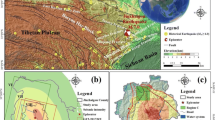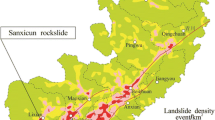Abstract
Among the geo-hazards caused by the great Wenchuan Earthquake, the rapid and long runout rockslide-debris flow is of primary concern due to the large volume of displaced material and the resultant catastrophic impacts to the landscape and socioeconomic structure. In order to analyze the dynamical process of this kind of geo-hazard, the Donghekou rockslide-debris flow is given as an example in this paper. This event, which killed 780 people, initiated at an elevation of 1300 m with a total long run-out distance of more than 2400 m. The slide mass is mainly composed of dolomite limestone and siliceous limestone of Sinian system, together with carbon slate and phyllite of Cambrian. During the processes from slide initiation to the final cessation of slide movement, five dynamic stages took place, here identified as the initiation stage, the acceleration of movement stage, the air-blast effect stage, the impact and redirection stage and the long runout slidematerial accumulation stage. Field investigations indicate that due to the effects of the earthquake, the dynamics of the Donghekou rockslide-debris flow are apparently controlled by geologic and tectonic conditions, the local geomorphological aspects of the terrain, and the microstructural and macroscopic mechanical properties of rocks which compose the slide mass. These three main factors which dictate the Donghekou rockslide-debris flow dynamics are discussed in detail in this paper, and significant results of field investigations and tests of materials are presented. The above dynamical processes are analyzed in this paper, and some useful conclusions have been gained.
Similar content being viewed by others
References
Cheng QG, Zhang ZY and Huang RQ (2007) Study on dynamics of rock avalanches: state of the art report. Journal of Mountain Science 25(1):72–84
Keefer DV (1984) Landslides caused by earthquakes. Geological Society of America Bulletin 95(4):406–421
Li YF, Wang ZY, Shi WJ et al. (2010) Slope debris flows in the Wenchuan Earthquake area. Journal of Mountain Science 7(3):226–233
Papadopoulos GA and Plessa A (2000) Magnitude-distance relations for earthquake-induced landslide in Greece. Engineering Geology, Special Issue 58:377–386.
Sassa K (2004) The international consortium on landslides. Landslides 1(1):91–94
Schrere RL (1968) Leaking and fluidization in air layer lubricated avalanches. Geological Society of America Bulletin 79:654–758.
Sun P, Yin YP, Wu SR et al. (2009) Experimental study on shear strength of rocks from Donghekou landslide in dried state and saturated state. Geological Bulletin of China 28(8):37–41. (In Chinese)
Sun P, Yin YP, Wu SR et al. (2009) An experimental study on the initiation mechanism of rapid and long run-out loess landslides triggerred by earthquake. Hydrogeology and Engineering Geology 17(4): 449–454. (In Chinese)
Sun P, Zhang YS, Yin YP et al. (2009) Discussion on long runout sliding mechanism of Donghekou landslide-debris flow. Journal of Engineering Geology 17(6):737–744. (In Chinese)
Su FH, Cui P, Zhang JQ et al. (2010) Susceptibility assessment of landslides caused by the Wenchuan Earthquake using a logistic regression model. Journal of Mountain Science 7(3): 234–245
Wang JD and Zhang ZY (1999). A study on the mechanism of high speed loess landslide induced by earthquake. Chinese Journal of Geotechnical Engineering, 6(21): 670–674
Wang SJ and Wang XN (1989) Analysis of energy on large-scale high speed landslide and their catastrophic prediction. In: Selected Papers on Landslide]. Chengdu: Sichuan Science and Technology Press. pp 117–124.
Wang M, Qiao JP and He SM. (2010) GIS-based earthquake-triggered landslide hazard zoning using contributing weight model. Journal of Mountain Science, 7(4): 339–352
Wang J, Yao LK and Arshad H (2010) Analysis of earthquake-triggered failure mechanisms of slopes and sliding surfaces. Journal of Mountain Science 7(3):282–290
Xiao SG, Feng WK and Zhang JJ (2010) Analysis of the effects of slope geometry on the dynamic response of a near-field mountain from the Wenchuan Earthquake. Journal of Mountain Science 7(4): 353–360
Yin YP (2009) Papid and long run-out features of landslides triggered by the Wenchuan Earthquake. Journal of Engineering Geology, 17(2):153–164
Zhuang JQ, Cui P, Hu KH et al. (2010) Characteristics of earthquake-triggered landslides and post-earthquake debris flows in Beichuan County. Journal of Mountain Science 7(3): 246–254
Zhang Y, Feng WP, Xu LS et al.(2009) Spatio-temporal rupture process of the 2008 great Wenchuan earthquake. Science in China Series D: Earth Sciences, 52(2): 145–154
Author information
Authors and Affiliations
Corresponding author
Rights and permissions
About this article
Cite this article
Sun, P., Zhang, Y., Shi, J. et al. Analysis on the dynamical process of Donghekou rockslide-debris flow triggered by 5.12 Wenchuan earthquake. J. Mt. Sci. 8, 140–148 (2011). https://doi.org/10.1007/s11629-011-2112-9
Received:
Accepted:
Published:
Issue Date:
DOI: https://doi.org/10.1007/s11629-011-2112-9




